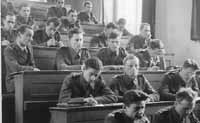The Polish Army
In
France
1939 - 1940
2DSP
As Europe slipped towards war, numerous Polish émigrés working in France found themselves trapped between the need to
work and maintain their normal lives or watch their country obliterated so soon after regaining independence. Poland and France had
been culturally linked since Napoleonic times and during the 1920s and 1930s France had received many émigrés who either worked
in the coalmines of northern France or in the factories located in major cities throughout France. As war neared many felt a ‘calling’ to
defend an independent Poland. See Operation Monika/POWN.
The gates reopen at Coétquidan in Bretagne, northern France for the first recruits. Described by Piotowski (1943:45) as
‘a gloomy place - flimsy, wooden barracks built at the time of the last war by the American Army’.
Dressed in old horizon blue and capped with oversized navy blue berets from the quartermasters’ stores of the previous war and
without weapons, the volunteers despite very different backgrounds were resilient and ready to defend France and Europe.
Those
with an education to degree level were put into an officer’s cadre and former combatants assisted in all ranks the development of their
duties according to rank including the revival of marching songs of the Pilsudski’s Legion or the nationalistic anthem
Boze cos Polske.
Lack of equipment, arms to train with and even proper washing facilities did not deter the idealistic of the volunteers. Colonel
Grzedinski commanded the camp prior to the camp being moved south into the Lorraine near Colombey-les-Belles, southwest of
Nancy when it was taken over by General Bronislaw Duch and renamed the 1st Grenadier Division in honour of the Poles who
fought under Napoleon. Only 8% of the troops were émigrés volunteers and the Division was largely made up of escaped army
personnel who all had adventures to tell. The 1st Regiment was commanded by Colonel Lowczowski and the 2nd Regiment by
Colonel Zientkiewicz. The Polish Army had been organized prior to 1939 upon a French concept, so by chance was able to integrate
quickly into the French command structure. The 1st Regiment was sent to Wittlesburg - the gap in the Maginot Line of
some 20 Km.
The 2nd Division (2DSP) was based between late December 1939 and May 1940 at Parthenay in Eastern France. Commanded
by Brigadier-General Prugar-Kietling the division was encharged with the defences around Belfort. The 3rd and 4th Infantry Divisions
were still being formed when France capitulated.
For the Polish Divisions, the capitulation by the French again left them in a quandary. Units continued to fight despite Pétain’s call for
armistice and demobilization on 16th June 1940 while the Poles covered the retreat. Polish units were cut off by the retreat and many
decided to sneak around German strongholds to avoid capture (Piotowski, 1943).
Brigadier-General Bronislaw Prugar-Kietling defended the Belfort area with 545 senior officers, 2,373 officers and 12,912 troops. The
First Division fought on until the 18th June and the 2nd Division decided to escape across the border into Switzerland on the 20 - 21st
June 1940. Brigadier-General Prugar-Kietling crossed into Switzerland at 5.30am as the first German tanks overran the remains of the
Franco-Polish defences.
At the border the Polish soldiers abandoned their arms and became interned under the control and protection
of General Henri Guisan. The interned Poles were encouraged to return to their studies and many took this option. The Universities of
Fribourg and Zurich together with the HEC at St. Gall and a Lycée camp at Wetzikon provided a wide variety of courses, particularly
in the sciences and maths. For others, the farms, mines and forests provided work. Some work details were based in the mountains
building roads, bridges and trails that are still in use today.

|
|

|
|
Some faculties had a Swiss dean assisted by a faculty of Polish lecturers all
of whom had escaped from the prestigious universities in Poland at the outbreak of war. The academic collaboration was excellent.
|
Brigadier-General Prugar-Kietling clandestinely remained in contact throughout the war with the Government-in-Exile based in
London. He had secret radio contact from bases code named ‘Vera’ and ‘Panorama’.
Little information is publicly available, but see
Réserve de GQG Order of Battle / Ordre de bataille, 10/05/1940
Top of Page
|